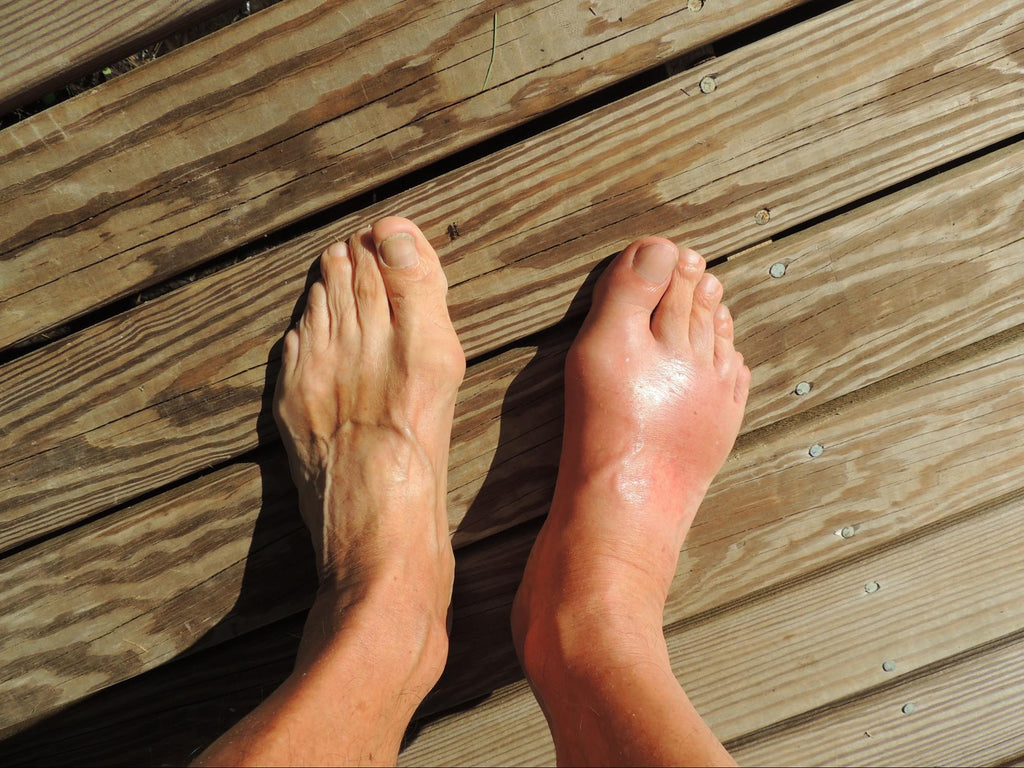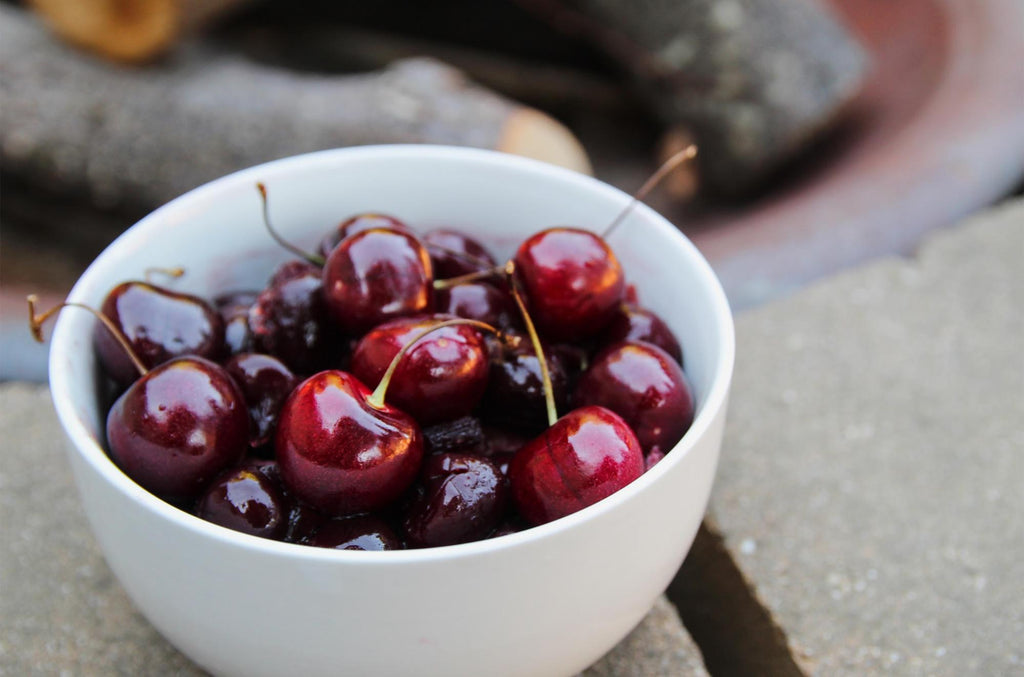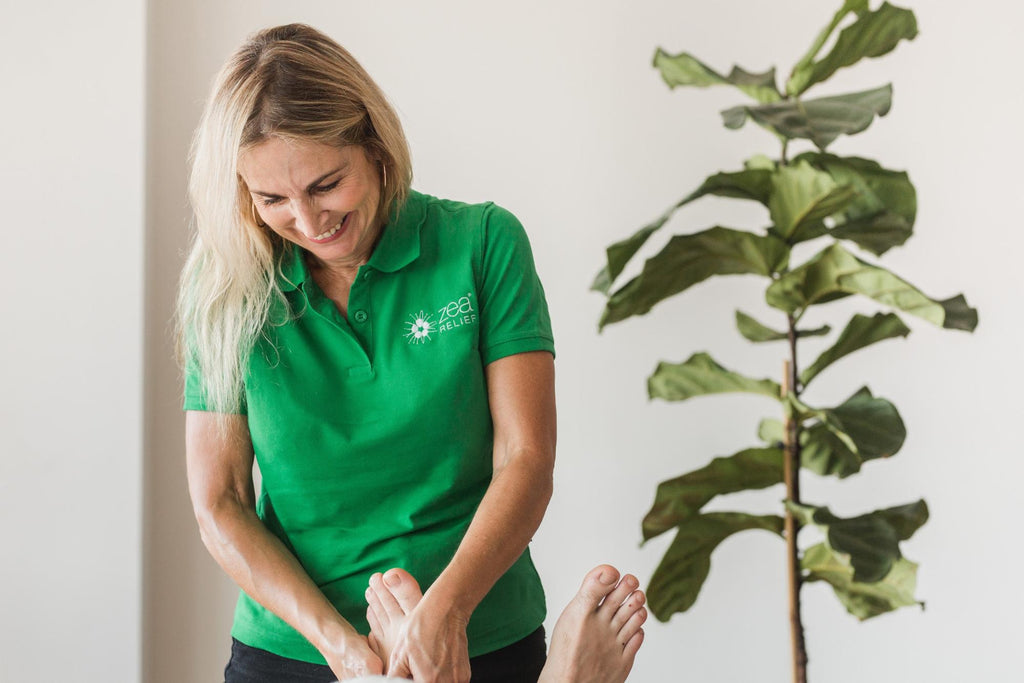Cases of gout date back to the Ancient Egyptians, making it one of the world’s oldest recorded diseases. It was once named “the rich man's disease” or “king’s disease” as it was linked to the “rich” diet - heavy in meat and alcohol - associated with wealth many years ago1.
Today, gout progression is linked with diet, weight, stress, and injury. Without treatment, gout will generally get worse and flare ups may be triggered by certain factors.
Let's take a look at what gout is defined as, what causes it and some suggestions on how you may be able to naturally manage the symptoms of this very debilitating inflammatory condition.
What is Gout?
Gout is an increasingly common, painful form of arthritis. It causes inflammation in the joints and usually only affects one or two joints at the same time - most commonly affecting the ball of the big toe.
Gout occurs when there is too much uric acid in the blood, tissues, and urine16. As uric acid crystallises, it takes on the shape of a needle and jabs its way into the joints2.
During the 17th Century, it was memorably described by English physician and gout sufferer, Dr Thomas Sydenham, as follows:
“The victim goes to bed and sleeps in good health. About two o’clock in the morning he is awakened by a severe pain in the great toe; more rarely in the heel, ankle, or instep. The pain is like that of a dislocation, and yet parts feel as if cold water were poured over them. Then follows chills and shivers, and a little fever. The pain which at first was moderate becomes more intense. With its intensity the chills and fever increase. After a time this comes to a height accommodating itself to the bones and ligaments of the tarsus and metatarsus. Now it is a violent stretching and tearing of the ligaments, now it's a gnawing pain, and now a pressure and tightening. So exquisite and lively meanwhile is the feeling of the pain affected, that it cannot bear the weight of bedclothes nor the jar of a person walking in the room2.”
Dr Syndenham’s representation of gout still rings true today.
Gout affects millions of people throughout the world - it is estimated to affect 5-10% of the population, most commonly affecting men 40+ and post-menopausal women2.
It’s important to understand that if left untreated, high levels of uric acid can lead to kidney damage and kidney stones, which occur if uric acid levels in the blood remain consistently high.
It’s vital to reduce uric acid and do what you can to keep it under control.

The 4 Stages of Gout
Stage 1 - High Uric Acid Levels
The first stage of gout is a buildup of uric acid in the body when the kidneys aren’t efficiently able to process it. Often referred to as ‘asymptomatic hyperuricemia’, this early stage of gout isn't usually present with pain or swelling, just higher levels of uric acid in the blood that start to crystalise if not treated3.
Stage 2 - Acute Gout
The second stage of gout is known as ‘acute gout’, when the crystalised uric acid are released into the joint fluid. This can present as a sudden, overnight flareup - often in the big toe, feet, ankles or knees, causing inflammatory symptoms such as pain, swelling, and redness. A medical professional can diagnose the inflammation as gout by testing for uric crystals in the joint fluid3.
Stage 3 - Intercritical Gout
After an acute flare up has subsided, 75% of gout sufferers will experience another bout within a year. Rheumatologist Theodore Fields refers to this as the ‘in between phase’ where patients have stopped experiencing acute gout symptoms but still need to be making changes to keep uric acid levels down to prevent further flare ups or from moving into stage 43.
Stage 4 - Chronic Gout
Chronic gout occurs as a result of unmanaged, long-term gout where no changes have been made to reduce inflammation or uric acid in the body. This stage is also referred to as ‘tophaceous gout’ because the uric acid crystals have hardened and formed nodules in the joints3.
The best way to prevent gout flare ups from worsening, it’s important to seek professional medical advice, but there are some simple and natural ways to manage gout and inflammatory symptoms. Below are some suggestions that you might find useful.
6 Recommended Treatments for Managing Gout
1) Low-Purine Diet
As with all inflammatory conditions, nutrition is the first place to make changes. Always consult a trained professional for your specific needs, but you may find some of these suggestions a helpful starting place:
- Avoid Purine-rich foods - Purines are organic compounds that contribute to uric acid formation, so lowering your intake of purine-rich foods can be helpful2. Purines increase lactate production and compete with uric acid for excretion, which can lead to a buildup of uric acid. Purine-rich foods to avoid include shellfish, red meat, foods containing yeast such as beer and bread, anchovies, asparagus, mushrooms, and sardines2.
- Limit alcohol intake - Alcohol increases uric acid, so it’s best to avoid it where you can.
- Avoid stimulants - This can include spices, tobacco, and sugar4.
- Eat Cherries/Drink Cherry Juice - Fresh or frozen cherries have been found to be effective in lowering uric acid levels and preventing attacks of gout3. Cherries contain anthocyanins that increase collagen integrity and decrease inflammation.
- Eat Alfalfa - Alfalfa is a good source of minerals and other nutrients that help to reduce serum uric acid. 2000-3000mg daily is recommended2.
You can read more in our article Feeling Sore? Anti-Inflammatory Foods That Help.

2) Supplements
Supplements can be an efficient and effective way to get more nutrients into the body to support our system with reducing inflammation and managing gout. It’s important to speak with a health professional before adding supplements to your routine to make sure you get personalised recommendations, but here are some supplements we find helpful:
- Omega 3 - many people are deficient in essential fatty acids, particularly in the Western world. Omega 3 Oil (EPA) limits the production of the inflammatory leukotrienes that are the key mediators of the inflammation seen in gout3.
- Folic acid - has been shown to inhibit the enzyme responsible for producing uric acid, (xanthine oxidase). Research has demonstrated that a derivative of folic acid is even more effective in inhibiting this enzyme than “allopurinol” - the most widely used drug for gout, suggesting that folic acid at high doses may be an effective treatment of gout6. Folic acid in high dose however should only be used under supervision of a physician as it may mask other health problems or interfere with other pharmaceutical drugs3.
- Turmeric - another great anti-inflammatory food, turmeric can be added to most dishes or taken as a supplement.
3) Reduce Consumption of Carbohydrates and Fructose
As with any inflammatory conditions, excess pressure on the joints can lead to developing gout and triggering flare ups5.
Weight reduction can also reduce serum uric acid levels so following a high fiber, low fat diet should help to manage elevated cholesterol and triglyceride levels3.
Consumption of refined carbohydrates and fructose should also be kept to a minimum as simple refined sugars also increase uric acid. Basically by lowering carbohydrates in the diet you will reduce production of uric acid and increasing good quality protein will support the excretion of uric acid.
4) Drink Plenty of Water
Drink at least 2-3 litres of water daily, as liberal fluid intake keeps the urine diluted and promotes the excretion of uric acid. Dilution of urine will also reduce the risk of kidney stones7.
Remember, if you are drinking tea or coffee (which should be limited) these beverages dehydrate the body, so in addition to the above, drink another glass of water to every tea or coffee consumed in order to stay hydrated.
5) Reduce Inflammation & Swelling
There are several naturally anti-inflammatory options that are worth trying to help reduce inflammation and swelling from gout. Not only for acute attacks, but also as maintenance to help prevent further painful episodes.
It is important to address diet first and then help to reduce the inflammation further with the following suggestions:
- Regular Massage - Massaging anti-inflammatory essential oils into the area around the painful joint may help relieve pain and encourage the elimination of acid deposits4. We recommend trying our Concentrated Massage Oil, which has been specifically formulated for treating acute areas of discomfort. Gently massage the oil into the area around the symptomatic area.
- Foot Bath - This is recommended when the gout is primarily affecting the toe. Add ½ cup of Kunzea Bath Salts to warm water and soak the feet/foot for at least 20 minutes.
For added benefit, gently rub Kunzea Cream in and around the affected joint following the foot bath.
- Ice Packs - This is a good treatment to help reduce swelling and inflammation associated with gout. Wrap a pack (a bag of crushed ice or frozen peas) in a dish cloth and apply to the area for 20 minutes a stretch several times a day.
- Elevate your foot - Raising your foot with a cushion so it’s higher than your chest may help lessen swelling.
You can also read more about managing and understanding inflammation here.
6) Prescription Medicine
Fortunately, gout is one of the most well-understood forms of arthritis. This is largely due to its long history. While we always have a preference for natural treatments and home remedies, it would be remiss of me not to mention the various prescription medicine options available to you.
During an acute gout flare up, the main objective of a prescription drug treatment is to reduce pain, inflammation and swelling. There are three categories of drugs used for calming the attack: NSAIDs, colchicine, and corticosteroids. After a flare ends, long-term treatment can begin to prevent and limit the amount of uric acid your body produces and prevent further attacks.
To learn more about prescription medicine options, speak to your doctor or medical practitioner.

Getting Gout Under Control
The basic thing to remember is that if you do get gout, it’s imperative to reduce uric acid levels within normal range through dietary changes and supplementation, maintain normal weight range, avoid foods known to initiate acute episodes, and reduce the inflammation where possible.
As a massage therapist and naturopath, I have been treating clients with gout for many years and, although sometimes there is a hereditary predisposition, in most circumstances a change in dietary and lifestyle habits can certainly help manage the pain and help minimise attacks.
While the progression of gout is manageable and preventable, it is essential that you start treatment as quickly as possible. The sooner you get it under the control, the easier it will be to treat.
About the Author - Michelle Brass ND
With over 25 years of experience in the natural health industry, Michelle has dedicated her life to helping others embrace the therapeutic benefits of nature. Throughout her time as a health practitioner, she has used and recommended countless traditional and conventional treatments to her clients - as she believes an integrative approach to health and wellness is very important. Michelle is passionate about using and promoting essential oils and, in particular, Kunzea Oil, as she has seen them help thousands of people over the years. She knows that using essential oils in your daily life can help bring balance to the mind, body and soul. She is constantly trialling and testing new products with her loyal clients.
To learn more about Michelle, go to her full bio page.
Medical DisclaimerAll content by Australian Kunzea Pty Ltd, including, text, images, audio, or other formats, were created for informational purposes only. The content is not intended to be a substitute for professional medical advice, diagnosis, or treatment. To read our full medical disclaimer, click here.
References
- Richette P, Bardin T (January 2010). "Gout". Lancet. 375 (9711): 318–28. doi:10.1016/S0140-6736(09)60883-7. PMID 19692116.
- Balch, J. F., Balch P. A. Prescription for Nutritional Healing. 2010.
- Murray, M and Pizzorno, J. Encyclopaedia of Natural Medicine. 2012.
- Harris, M., Siegel, L,B., Alloway J. Gout and Hypouricemia. American Family Physician. https://www.aafp.org/afp/1999/0215/p925.html. Accessed 5 August 2020.
- Pi-Sunyer F.X. The Fattening Of America. 1994.
- Spector, T and Ferone, R. Folic Acid Does Not Activate Xanthine Oxidase. https://pubmed.ncbi.nlm.nih.gov/6547955/ Accessed 6 August 2020.
- Krause, M.V. and Mahan, L.K. Food, Nutrition and Diet Therapy. 7th Ed. 1984.
- Arthritis Foundation. Gout.
- Gout. (n.d.). arthritis.org/arthritis-facts/disease-center/gout.php
- Gout. (2017). https://www.cdc.gov/arthritis/basics/gout.htm
- Mayo Clinic Staff. (2018). Gout. https://www.mayoclinic.org/diseases-conditions/gout/symptoms-causes/syc-20372897
- Mayo Clinic Staff. (2015). Gout diet: What’s allowed, what’s not. https://www.mayoclinic.org/healthy-lifestyle/nutrition-and-healthy-eating/in-depth/gout-diet/art-20048524
- Ragab G, et al. (2017). Gout: An old disease in new perspective - a review. 10.1016/j.jare.2017.04.008
- Questions and answers about gout. (2012). https://www.niams.nih.gov/health-topics/gout
- Zhang Y, et al. (2012). Cherry consumption and the risk of recurrent gout attacks. https://www.ncbi.nlm.nih.gov/pmc/articles/PMC3510330/
- WebMD. Gout Pictures Slideshow: Causes, Symptoms, and Treatments of Gout. https://www.webmd.com/arthritis/ss/slideshow-gout. Accessed on 11 August 2020.



